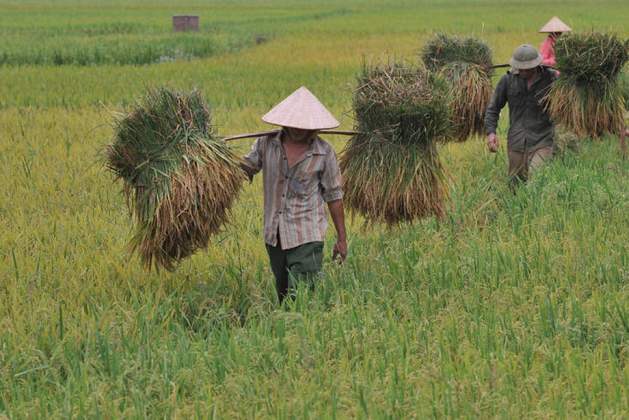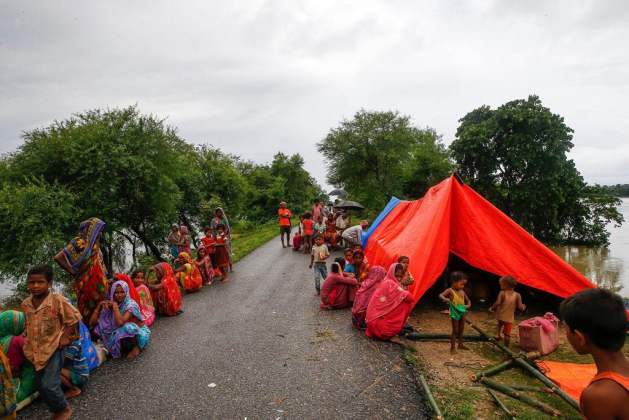Friday, April 19, 2024
News and Views from the Global South
Climate Change
Global Warming Puts Asia’s Vital Yields at High Risk

Displaced by the floods, a woman and her child walk along a road in southern Nepal. Photo: UNICEF Nepal/NShrestha
- While mainstream media have been widely reporting on the dramatic consequences of tropical storm Harvey in the United States, which has been characterised as the fiercest hurricane to hit this country in over a decade, global warming is expected to have a significant impact on “future yields of everything from rice to fish, particularly in countries situated closer to the equator,” the United Nations warned.
Geographically, the negative impact of climate change on agricultural output could result in lower yields of rice, wheat, corn and soybeans in countries with tropical climates, compared with the impacts experienced by those in higher latitudes, the UN Food and Agriculture Organization (FAO) reported.
Fisheries could also be affected by changes to water temperature.
At the meeting in Viet Nam of agriculture ministers from Asia-Pacific Economic Cooperation (APEC) on 25 August, the UN specialised body informed that many key agricultural regions in Asia are “already at risk of crossing key climate thresholds after which the productivity of plants and animals goes into decline.”
For example, research by FAO and other organisations has found that there are regions within Asia that are already near the “heat stress limits” for rice. Changes in specific climate variables are important too –for example, increased night-time temperatures have been found to have a significant negative impact on rice yields.
Based on the findings of the global research community, the International Panel on Climate Change (IPCC) anticipates that these trends are expected to worsen in the future with the projected impacts of anthropogenic climate change, FAO reminded.

Harvesting rice in Viet Nam. Global rice consumption trends are rising. Photo: FAO/Hoang Dinh Nam
The Full Force of Agriculture Losses
Many APEC economies have already felt the full force of agricultural losses from natural disasters in recent years, with the vast majority of these being climate related, said Kundhavi Kadiresan, Assistant Director-General and FAO Regional Representative for Asia and the Pacific.
“The annual tally runs into the billions and billions of dollars in losses. So the time to act is now. Policy makers need to prepare for changes in supply, shifting trade patterns and a need for greater investment in agriculture, fisheries, land and water management, that will benefit smallholder farmers and others that produce our food.”
According to Kadiresan, it is “imperative that we start thinking now about the hard decisions and actions that the APEC economies, and others, will need to take.”
The agriculture sectors account for at least one-fifth of total emissions, mainly from the conversion of forests to farmland as well as from livestock and paddy production and application of synthetic fertilisers.
And it has been estimated that as much as 70 per cent of the technical potential to reduce emissions from the agriculture sectors occurs in tropical developing countries that characterise much of Asia.

People displaced by the floods take temporary refuge along a road in southern Nepal. Photo: UNICEF Nepal/2017/NShrestha
Action Underway
In Viet Nam, the UN specialised body has been working with the Ministry of Agriculture and Rural Development to assess the emissions reduction potential of the System of Rice Intensification and improved livestock management as contributions to Nationally Appropriate Mitigation Actions and Viet Nam’s priorities for agriculture.
In Cambodia, Papua New Guinea and Mongolia, FAO, in partnership with the Global Environment Facility (GEF), has recently started developing programmes under the Capacity Building Initiative for Transparency to strengthen national level capacity to measure, monitor and report emissions and adaptation actions in the agriculture and land-use sectors.
These programmes draw upon a range of geospatial and measurement tools FAO has developed through its global programme on Mitigating the Impacts of Climate Change in Agriculture.In the forestry sector, avoiding deforestation, increasing the area under forest, and adopting sustainable forest management will create invaluable carbon sinks. FAO has been supporting national programmes for reduced emissions from deforestation and forest degradation (REDD+).
APEC, as an organisation of Pacific Rim economies, “is well placed to take on a leading role, with strong and wide ranging political commitment, given that its membership includes several of the world’s largest and wealthiest economies, as well as some of the smallest and poorest. “
Many are home to some of the finest research institutes with some of the brightest minds, it added. “APEC could, thus, set an example for the rest of the world.”
Millions Affected by Flooding, Landslides
The ministerial meeting took place while UN humanitarian agencies were –and still are–working with the government and partners in Nepal to bring in clean water, food, shelter and medical aid for some of the 41 million people affected by flooding and landslides in South Asia.
Nearly a thousand people have been killed, and tens of thousands of homes, schools and hospitals have been destroyed in Bangladesh, India and Nepal, the UN reported.
“There is the possibility that the situation could deteriorate further as rains continue in some flood-affected areas and flood waters move south,” the UN Office for the Coordination of Humanitarian Affairs (OCHA) on 24 August said.
In Bangladesh, nearly 2,000 local medical teams have been deployed, even as one-third of the country is reportedly underwater. Aid workers are concerned about waterborne diseases, such as diarrhoea and malaria.
“Their most urgent concern is to accessing safe water and sanitation facilities,” OCHA said, citing national authorities.
It also warned of “dangers to women and children, who are at increased risk for abuse, violence and sexual harassment. “
In India, rescue operations are on-going in many flood-affected areas, with those stranded being rescued by helicopter. Flood relief camps have been established for those displaced by the disaster where they are being provided with food and shelter, OCHA said.

 Print
Print



